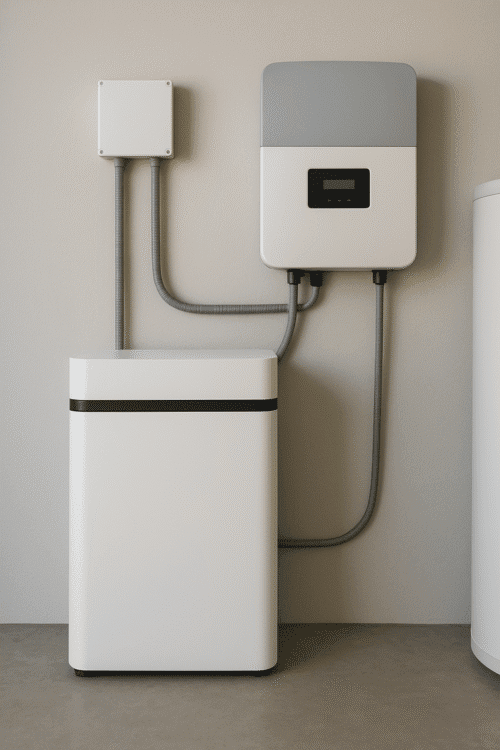
Eliminating Behind-The-Meter Energy Storage Limits is Essential for Enabling Resilience
This blog post advocates for permanently providing Californians with the ability to deploy oversized energy storage behind-the-meter (BTM) to support customer-sited resilience and grid reliability
Eliminating Behind-The-Meter Energy Storage Limits is Essential for Enabling Resilience
Permanently providing Californians with the ability to deploy oversized energy storage behind-the-meter (BTM) supports customer-sited resilience and grid reliability. Both goals are directly aligned with well-established state policies.
The resilience value of standalone solar PV is limited, at best. Even with an inverter capable of islanding, as the sun goes down, the availability of energy generated by the solar system slows down until it completely stops producing by the time night falls. Paired energy storage is the critical component of a resilient energy solution that enables the time shifting of energy for use during grid outages, regardless of what point in the day an outage occurs.
When a customer desires resilience, correctly sizing the energy storage system becomes a balancing act; the energy storage is designed to be cycled on a daily basis for economic optimization. Storing energy from the solar system during the middle of the day when prices are the lowest and discharging it to offset onsite loads during the system peak from 4-9 p.m. when the grid is the most congested results in the highest rate of return. However, to properly provision resilience, a certain amount of the battery’s state of charge must be reserved to power critical loads in the event of an outage, irrespective of when in the day it may occur. If the battery is fully discharged solely for economic purposes, there may be insufficient supply if a grid outage occurs toward the end of the peak period—when the energy storage is almost fully discharged—or during the middle of the night when the solar system is no longer generating. As a result, the best solution is deploying a large, oversized battery that is capable of achieving both outcomes.
Oversizing, or deploying a larger energy storage system with a greater energy capacity than the size of the solar, is important when resilience is a priority in order to ensure that the normal economic benefits that justify the solar+storage deployment in the first place can be maintained in addition to the state of charge needed to provision resilience. When the Clean Coalition designs Solar Microgrids, we recommend a ratio of 1:2, solar to storage. See our Solar Microgrid Methodology for more information. The larger the size of a storage system, the longer duration of resilience that can be achieved, and the more loads that can be sustained during an outage as long as the solar system can fully charge the energy storage.
Beyond customer resilience, oversized BTM storage also directly supports grid stability. By capturing more midday excess solar that would otherwise be curtailed and discharging during peak demand, oversized batteries reduce stress on the transmission system, provide critical ancillary services, and defer expensive grid upgrades. Allowing oversized BTM storage diminishes the need for costly utility-scale transmission and distribution upgrades and keeps overall system costs lower for all Californians.
Under the original Net Energy Metering (NEM) program, the size of a storage system was limited to 150% of the size of the paired renewable energy generating system. However, in 2020, the California Public Utilities Commission (CPUC) removed any restrictions on sizing paired NEM energy storage systems as part of a slate of short-term actions designed to accelerate BTM storage, benefit reliability, and promote customer-sited resilience. In the subsequent five years, the utilities have found that removing the sizing limit has not caused any major issues, grid imbalances or challenges related to grid exports. Now, with the original sunset date for the policy that lifted the sizing restriction, it is more essential than ever that California policymakers understand the value of energy storage and permanently eliminate any BTM paired storage sizing limits.
In July, the Clean Coalition submitted a response to the CPUC in complete support of a petition by the California Solar and Storage Association urging the CPUC to completely eliminate any BTM energy storage sizing limits once and for all. The initial exemption provided in 2020 was both a short-term action to promote resilience following Public Safety Power Shutoffs and an experiment to verify that the action would not have any long-term adverse impacts. With the investor-owned utilities concluding that the grid can handle oversized BTM storage and the increasing need for resilience as the climate changes, it is critical that customers have the ability, without size restrictions, to deploy energy storage systems needed for resilience. Moreover, with Virtual Power Plants (aggregations of solar and solar+storage systems) capable of assisting with grid reliability during peak periods during the year and saving the ratepayers millions of dollars, large BTM storage systems are doubly valuable.
California’s clean energy future depends not only on deploying solar, but on pairing it with storage sized for both customer resilience and grid reliability. The evidence is clear: oversized BTM energy storage poses no technical risk to the grid, yet delivers substantial economic, environment, and resilience benefits. By permanently eliminating BTM storage sizing limits, the CPUC can empower Californians to protect their communities, reduce ratepayer costs, and advance state climate and resilience goals. The time to act is now.

